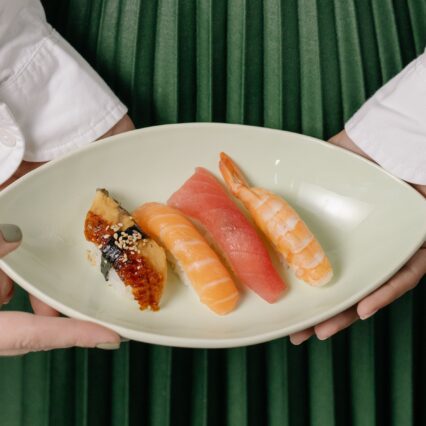Sushi Night at Home

Sushi Night at Home
There are of course many different forms of sushi — namely nigiri, makizushi, sashimi, temaki, and chirashi — but today we’ll focus on makizushi (rolled sushi) – for multiple reasons. For one, going over all of them would make for a super long post. Further, makizushi is the most ubiquitous sushi to many North Americans, and in Japan makizushi is considered the most accessible “at home” sushi.
Before we get into some of the tips and minutiae of making sushi at home — and this minutiae makes a big difference — there are some staples and other options you’ll want on hand.
What You’ll Need for Making Sushi at Home
For starters, the foundations for making sushi:
Everyone says this but it’s true: The rice is the basis for good sushi. You know the “minutiae” we mentioned above? Yeah, a lot of that will deal with how to make sushi rice.
Then, sushi-grade fish– an essential sushi ingredient. There are of course multiple options to choose from here, but popular and simple ones include:
- Maguro (tuna)
- Sake (salmon)
- Shiro maguro (albacore)
- Buri or hamachi (yellowtail)
- Ebi (shrimp)
Some people incorrectly assume that in order to make sushi at home, you have to buy expensive, fancy fish, but that doesn’t have to be the case. It’s really the quality and preparation of rice (as well as nori) that makes the biggest difference. The main concern with the fish is that it’s fresh and safe, which is why the sushi-grade designation is important.
That being said, “sushi-grade” is an unregulated term — it’s simply a fishmonger’s way of declaring that they prepared the fish in such a way for it to be consumable raw. For this reason, we seriously recommend getting your fish from a fishmonger you trust. Uwajimaya’s seafood department has decades of experience here providing quality, fresh fish for making sushi at home.
Now, moving on to other possible sushi ingredients for your makizushi rolls:
These of course are all up to you, but they’re good options to start with for making sushi. As for the roe, this could be masago or tobiko (smaller and crunchier, from the capelin or flying fish), or ikura, which is the much larger, richer salmon roe. The latter especially can be its own sushi roll. We recommend it. It’s delicious.
Lastly, some other add-ons that might suit your sushi night at home:
- Tamago (Japanese omelette)
- Pickled daikon radish
- Kaiware daikon (daikon sprouts)
- Pickled ginger
- Seasoned shiitake
- Spicy mayo
Just like the others, these too are up to you. Shiitake, for example, isn’t super commonly used as a sushi ingredient, but if you’re vegetarian or just a big fan, it can be a tasty alternative sushi filling.
Tamago meanwhile is a type of Japanese omelette that can be sliced and made into a nigiri or makizushi filling. Its simplicity makes tamago a mark of a cook’s technical skills and intuition — legendarily, certain restaurants in Japan will ask potential chef or cook hires to make tamago to assess their ability. Luckily tamago’s simplicity also allows a half-decent home cook to make a pretty good version even if it wouldn’t pass the gourmet chef test. This then can be a tasty, uncomplicated sushi filling.
Other than these, there are also some good appetizer and drink options that pair wonderfully for the perfect sushi night at home. This includes edamame, miso soup, seaweed salad, or gyoza to eat. To drink, hot sake or ice cold Japanese lager like Sapporo or Asahi is a perfect pairing with sushi. If you want something that marries equally well but without the alcohol, green tea is ideal.
Now Some Tips and the Minutiae We Spoke of Earlier

While professional sushi chefs will take years upon years to train and perfect their craft, it feels like a common misconception in North America that because of the expertise of professional chefs, making sushi at home is crazy complicated and/or almost impossible. Really, that’s not the case at all! No, you will not make as perfect sushi as a decade-trained, specialized chef — but that’s not the point.
What does connect both the professional sushi chef and the home cook is not neglecting the sushi rice in this equation. Sure, the professional will have spent years just learning how to perfect sushi rice unlike you, but even without that expertise there are still important and simple steps to take so that your sushi rice is as on point as possible.
First, the rice. The best rice to use for sushi is short-grain Japanese rice. Long grain rice, such as Jasmine, does not have the texture and starch to create the slightly sticky texture needed for sushi.
Next, rinse the rice liberally. You don’t want it stodgy or overly starchy and cohesive, nor do you want broken kernels. To both these ends, the rice should be rinsed — pretty gently, keep those kernels intact — until the water pouring through it is clear, which means that enough starch has been rinsed off.
You also will end up using slightly less water in the cooking preparation than for normal steamed rice, because the latter is more moist and the individual grains less prevalent than in sushi-prepared rice, as well as the fact that the later addition of vinegar adds moisture too.
Once the sushi rice is cooked, you should be working quickly but not over-handling it; too slow and the physical characteristics start to change, too over-handled and you’ll release starches that make it stodgy. When you have the rice both cooked and vinegared, you can store it for a few hours, but just make sure it’s covered with a damp cloth.
Other than the sushi rice, a few things to leave you with:
The Tools
You’ll need a bamboo mat for rolling, and this part takes a bit of experience and experimenting to get just right. Luckily, it’s pretty low stakes because everything will end up tasty regardless, even though it’ll probably take you a bit before your sushi-rolling skills are as smooth as you’d like. Along with figuring out how to roll your sushi cleanly, part of this is getting just the right pressure down as well by rolling it firmly but gently; you don’t want to roll your maki with so much pressure that you end up with an overly-dense roll where the ingredients are smushed, but you also need to roll tightly enough so that the roll is solidly held together.
Related, your knife should be very sharp and you should familiarize yourself with the slicing method. Both of these come down to the fact that you shouldn’t be “sawing” your sushi. Your slice should include as minimal back-and-forth motion as possible, but rather should be one smooth slice through as much of the roll as possible — through all of the roll is even better; an even slightly dulled knife will prevent you from being able to do this.
Lastly, keep it simple. Making sushi is like pizza: throwing a boatload of fillings or toppings into or onto it doesn’t make it good, it just makes it have a boatload of fillings or toppings. Putting 18 things in one roll just means every flavor is overshadowing every other flavor, so you’ll end up with a mushy flavor and you won’t actually be getting much out of each ingredient. Not to mention you’ll probably end up with so much food that you’re having sushi for a week. Although granted, that by itself doesn’t sound half bad.
Hopefully this gets you enthusiastic about making sushi at home, because it’s such a tasty dinner that’s much more accessible than we give it credit for.




